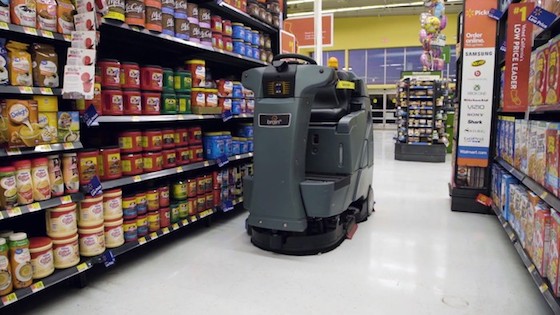Walmart’s robot floor cleaner scrubs and polishes all by itself [...]]]>
Walmart’s robot floor cleaner scrubs and polishes all by itself with no worker required to guide it, as shown below:
In addition, Walmart has been using inventory robots to keep its shelves adequately supplied. The machines scan to see what is needed, but cannot physically stock the needed merchandise — yet.
The following article talks as if regular Walmart employees clean the floors and the robots will allow them more time for “customer-centric” work — don’t the stores have janitors for that chore?
In fact, industrial janitor is a job which many low-skilled immigrants take, so perhaps we needn’t continue importing them when so many such occupations will soon be done by smart machines.
]]>AI-Powered, Self-Driving Robots Are Taking On a Bigger Role at Walmart Stores, Motley Fool, March 19, 2019
The world’s largest retailer is making a growing bet on robots and artificial intelligence to gain a competitive edge.
Competition in the retail industry has never been more cutthroat. The dawn of e-commerce has caused a paradigm shift, with traditional retailers having to change with the times or fall by the wayside.
Walmart (NYSE:WMT) is representative not only of the old guard of retail, but also of the transition that is happening among brick-and-mortar stores to adapt to this new reality. In addition to a fierce move into e-commerce, the once-stodgy retailer has embraced cutting-edge technology to help keep costs in check and provide a better shopping experience for its customers.
Case in point: Self-propelled robots are now taking on an increasing role in Walmart’s operations.
Walmart is using self-driving robots to scrub floors. Image source: Brain Corp.
The coming of the ‘bots
Walmart recently revealed it’s bringing self-driving robots powered by artificial intelligence (AI) to its stores to handle the mundane task of floor cleaning. The Auto-C — Autonomous Cleaner uses assisted autonomy as it navigates around Walmart stores, employing a variety of lasers, cameras, and sensors to scan its surroundings for people and obstacles. This technology allows the self-driving robots to function effectively and safely in complex, crowded environments, which leads to increased productivity and efficiency.This often-overlooked chore would typically take Walmart associates (what the retailer calls its employees) about two hours per day, on average. Multiply that by more than 11,000 stores worldwide and that’s a lot of time cleaning floors. Having a robot complete the task frees up Walmart employees for other, more customer-centric tasks.
The self-driving floor cleaners were initially tested in about 100 Walmart stores, and the company recently expanded that rollout to 360 stores. (Continues)
It has been forecast by various tech experts that a big chunk of jobs will be transferred to smart machines over the coming years, one being the 2013 prediction of Oxford University researchers that nearly half of American jobs were vulnerable to machine or software replacement within 20 years.
So paying attention to the coming automation revolution makes sense for our national plans about the future. For example, America won’t need to be importing a million immigrant workers a year when machines will soon be doing the jobs.
Automation will revolutionize retail for shoppers and workers; for example, the machine shown below replaces a greeter and clerk in Lowe’s hardware stores.
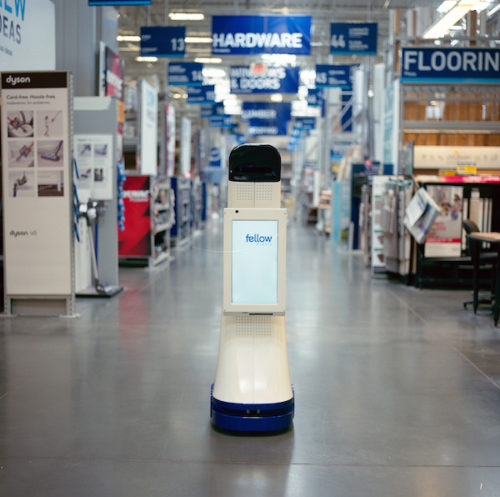
Martin Ford was recently interviewed by Retail Touch Points, a business website, about certain automation applications and an update about the technology.
]]>Exclusive Q&A: Which Retail Jobs Are Safe From A Robot Takeover?, Retail Touch Points, September 5, 2018
In an exclusive interview with Retail TouchPoints, Ford identifies the advances in robotics and AI that are accelerating the fastest. He also identifies a selection of job categories that are safe from the march of automation — at least for now.
Retail TouchPoints (RTP): You write in Rise Of The Robots that warehouse work and fast food are two places where we’re already seeing the impact of robotics on employment. Has that trend continued since the book came out in 2015?
Martin Ford: There have been advances in both areas, but the progress has had the most practical applications in warehouse work. You can find videos on YouTube showing robots moving boxes around. Nearly all the main distribution warehouses are automated to some extent, for example by bringing shelves to workers who then reach in and grab the items they need. I really think Amazon’s warehouses will get more efficient and less labor-intensive, which directly impacts Walmart.
In order to respond, traditional retailers with stores also will have to become more efficient. Walmart and others have been testing robots for taking store inventory by counting the things that are on the store shelves. Part of the nature of robotics is that it’s easier to make one designed just to observe something, versus building a robot that physically does something like pick up a box. Eventually, however, robots will be unloading trucks or putting items on shelves, particularly in areas where the products are standardized. That’s probably inevitable.
In the fast food area, there are at least three startups in terms of actually preparing food. Momentum Machines, now called Creator, has a robot that shapes burgers from freshly ground meat and grills them to order, and it can produce 360 burgers per hour. They just opened a storefront in San Francisco in order to test the technology. There’s also a company called Zume that is using robots to make pizzas. Their business model is to put the uncooked pizzas in a van equipped with an oven and have it cooked while it’s on the way to the delivery destination, so that it’s virtually right out of the oven when you get it.
RTP: You also write about the impact of cloud robotics, which migrates the intelligence needed to animate mobile robots to a centralized hub, as a technology that’s likely to affect jobs. Why is this technology important?
Ford: Some people say ‘Well, I might lose my job doing such-and-such, but I can get a job fixing the robots.’ It’s true that repair and maintenance will create some jobs, but certainly not as many as will be lost. Take the Redbox video boxes, which can sense when there’s a mechanical or software issue with one of them and send an alert about that. All of these types of systems will be built in a way that’s very modular and easy to maintain, probably remotely and in some cases autonomously. That’s a part of the business model.
RTP: Are there jobs where we might be surprised to see robots, AI or other technologies replacing humans?
Ford: People have been biased toward the idea of robots taking away blue-collar jobs, like warehouse workers, or truck drivers with self-driving vehicles. There’s not enough focus on the person that sits in a cubicle, whose job is a lot easier to automate in many ways. For one thing, as opposed to a self-driving car, if the machine makes a mistake, nobody gets injured or killed. People who are analysts cranking out reports, or putting data into an understandable format, in areas like accounting, finance and banking — all of these jobs will be increasingly susceptible to becoming automated.
We’re already seeing it in customer service. When you call a company for technical support, it’s increasingly likely that you will be talking to a machine, and it’s not clear whether that will be disclosed to the consumer. These solutions could get good enough so that people wouldn’t be able to tell, especially when the conversations are limited in terms of the topic areas.
RTP: Are there retail jobs that might be considered “safe” from automation?
Ford: Jobs involving creative and strategic thinking are one area. Another is jobs involving interacting with people, particularly if you need to build a sophisticated relationship, as in high-end retail. Another area is jobs where there’s a lot of mobility and dexterity involved. Outside of retail that would be electricians and plumbers, but even something like stocking shelves — particularly in a smaller store that has a lot of different products and different-sized shelves — will still need people. Also, the person that goes into the fitting room to restock shelves with clothes that are all in a jumble — pretty much anything that requires flexibility and dexterity in unpredictable environments is fairly safe.
RTP: What are some of the likely effects of a jobless future?
Ford: Workers are consumers, and the main way we get money into the hands of these consumers is their jobs. As these jobs go away or as wages fall, things become increasingly unequal. We’re already seeing the impact of inequality — I’ve seen surveys saying that the average person would not be able to come up with $500 in case they needed to fix a car or had medical expenses. If people have no discretionary income, they’re not driving the economy, because these people are really only buying essentials. (Continues)
Below, the Amazon Go store offers a modern [...]]]>
Below, the Amazon Go store offers a modern do-it-yourself checkout where shoppers just choose items they want and the cost is tallied up and deducted on their smart phones.
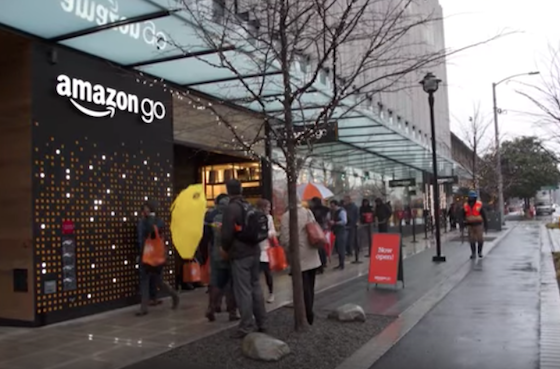
Here is Amazon’s explainer video about how the Go store works:
The article below, reprinted from the New York Times, explains how retailers and others “are motivated to shave labor costs” which points out the eventual catastrophic job loss that will come with automation across workplaces from agriculture to manufacturing and retail.
According to the US Bureau of Labor Statistics, retail workers account for millions of jobs. Statistics from earlier this year reported that 4,854,300 persons worked in retail sales in 2016.
So America won’t need any more immigrants when all sorts of jobs are disappearing because of automation, right? We will have enough trouble finding jobs for citizens.
]]>Retailers race against Amazon to automate stores, SFGate.com, April 2, 2018
SEATTLE — To see what it is like inside stores where sensors and artificial intelligence have replaced cashiers, shoppers have to trek to Amazon Go, the Internet retailer’s experimental convenience shop in downtown Seattle.
Soon, though, more technology-driven businesses like Amazon Go may be coming to them.
A global race to automate stores is under way among several of the world’s top retailers and small tech startups, which are motivated to shave labor costs and minimize shoppers’ frustrations, like waiting for cashiers. They are also trying to prevent Amazon from dominating the physical retail world as it does online shopping.
Companies are testing robots that help keep shelves stocked, as well as apps that let shoppers ring up items with a smartphone. High-tech systems like the one used by Amazon Go completely automate the checkout process. China, which has its own ambitious e-commerce companies, is emerging as an especially fertile place for these retail experiments.
If they succeed, these new technologies could add further uncertainty to the retail workforce, which is already in flux because of the growth of online shopping. An analysis last year by the World Economic Forum said 30 to 50 percent of the world’s retail jobs could be at risk once technologies like automated checkout were fully embraced.
In addition, the efforts have raised concerns among privacy researchers because of the mounds of data that retailers will be able to gather about shopper behavior as they digitize their locations. Inside Amazon Go, for instance, the cameras never lose sight of a customer once he or she enters the shop.
Retailers had adopted technologies in their stores long before Amazon Go arrived on the scene. Self-checkout kiosks have been common in supermarkets and other stores for years. Kroger, the grocery chain, uses sensors and predictive analytics tools to better anticipate when more cashiers will be needed.
But the opening of Amazon Go in January was alarming for many retailers, who saw a sudden willingness by Amazon to wield its technology power in new ways. Hundreds of cameras near the ceiling and sensors in the shelves help automatically tally the cookies, chips and soda that shoppers remove and put into their bags. Shoppers’ accounts are charged as they walk out the doors.
Amazon is now looking to expand Go to new areas. An Amazon spokeswoman declined to comment on its expansion plans, but the company has a job posting for a senior real estate manager who will be responsible for “site selection and acquisition” and field tours of “potential locations” for new Go stores.
“Unanimously, there was an element of embarrassment because here is an online retailer showing us how to do brick and mortar, and frankly doing it amazingly well,” said Martin Hitch, the chief business officer of Bossa Nova Robotics, a company that makes inventory management robots that Walmart and others are testing.
(Continues)
Below, the little orange Kiva robots scoot under racks of merchandise and deliver them to humans who fulfill the orders.
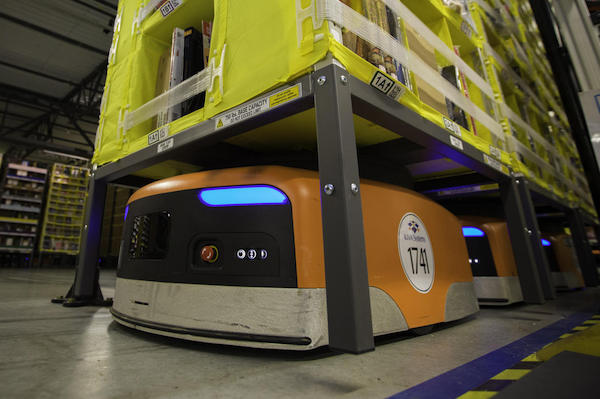
Today, many people find it easier to shop online than to spend hours to drive through traffic to a store that may not have what they want. Amazon’s recent record-breaking Cyber Monday following Thanksgiving illustrates its increasing success, along with Jeff Bezos’ ascent to becoming the richest man in the world.
The universe of work is undergoing a fundamental transformation because of automation and computers, and we’re just beginning to see how the future may function. Massive job destruction is a given, according to numerous tech experts. Oxford researchers forecast in 2013 that nearly half of American jobs were vulnerable to machine or software replacement within 20 years. Rice University computer scientist Moshe Vardi believes that in 30 years humans will become largely obsolete, and world joblessness will reach 50 percent. The Gartner tech advising company believes that one-third of jobs will be done by machines by 2025. The consultancy firm PwC published a report earlier this year that forecast robots could take 38 percent of US jobs by 2030.
Amazon may be adding employees now, but the company’s long term plans are to replace workers in their function of filling and packing customer orders as shown by the company’s annual Picking Challenge competition for robots.
And plenty of other industries from agriculture to accounting are incorporating more smart machines to save money.
So it makes no sense for America to continue importing millions of immigrants who expect to work here, right?
]]>Retail jobs decline as Amazon’s robot army grows, CNBC, December 4, 2017
Amazon employs over half a million workers. In the past year alone, the online retailer has added roughly a quarter of a million employees to its headcount, and 238 cities across the country are competing to become the location of Amazon’s second headquarters, which is estimated to create 50,000 more Amazon jobs.
But according to Dave Edwards and Helen Edwards at Quartz, Amazon may be killing more jobs than it creates. Quartz found that there are 170,000 fewer retail jobs in Amazon-related industries — like bookstores, grocery stores and clothing stores — in 2017 than the year before.
According to their calculations, even if Amazon maintains an impressive 43 percent personnel growth for another year, the total number of workers employed in Amazon-related industries would still decrease by 24,000.
So where are the jobs going? Quartz suggests that an increase in robotic workers could be to blame. They estimate that Amazon added 75,000 new robots to their workforce in 2017 for a total of roughly 100,000. By these approximations, machines constitute 20 percent of all Amazon “employees.”
More robots don’t always mean fewer jobs, but it may in the case of Amazon. Edwards and Edwards write, “While it may be difficult to prove causality, it’s not difficult to see the correlation between a decline of 24,000 human employees and an increase of 75,000 robot employees.”
Amazon attests that the investment in technological workers has improved efficiency. CNBC reports it takes 90 minutes on average for a human Amazon employee to find a product and package it, but with the help of robots, a product can be found and packaged in as little as 13 minutes.
(Continues)
As part of Wal-mart’s competition with Amazon, the store chain is utilizing Amazon’s technology strategy by moving forward with automation to up its e-commerce game.
Naturally, the efficiency and cost-savings [...]]]>
As part of Wal-mart’s competition with Amazon, the store chain is utilizing Amazon’s technology strategy by moving forward with automation to up its e-commerce game.
Naturally, the efficiency and cost-savings are emphasized, rather than the inevitable job loss.
Wal-Mart’s new robots scan shelves to restock items faster, Reuters, October 26, 2017
CHICAGO (Reuters) – Wal-Mart Stores Inc is rolling out shelf-scanning robots in more than 50 U.S. stores to replenish inventory faster and save employees time when products run out.
. . . “If you are running up and down the aisle and you want to decide if we are out of Cheerios or not, a human doesn’t do that job very well, and they don’t like it,” Jeremy King, chief technology officer for Walmart U.S. and e-commerce, told Reuters.
The company said the robots would not replace workers or affect employee headcount in stores.
The robots are 50 percent more productive than their human counterparts and can scan shelves significantly more accurately and three times faster, King said. Store employees only have time to scan shelves about twice a week.
The idea of installing robots to automate retail is not new. Rival Amazon.com Inc uses small Kiva robots in its warehouses to handle picking and packing, saving almost 20 percent in operating expenses. . .
Even more futuristic are the drone robots that fly around warehouses to do inventory, as the BBC recently reported:
The flying drones that can scan packages night and day, October 27, 2017
Flying drones and robots now patrol distribution warehouses – they’ve become workhorses of the e-commerce era online that retailers can’t do without. It is driving down costs but it is also putting people out of work: what price progress? . . .
What price progress indeed? A viable economy requires shoppers as well as products, but nobody in government seems concerned about the shrinkage of the demand side of the equation. Wouldn’t preparing for the automated future make more sense than pretending it isn’t coming?
Certainly America shouldn’t import more immigrant workers, since they won’t be needed. The remaining jobs should go to Americans, period, because:
Automation makes immigration obsolete.
Need convincing? Experts paint a grim picture:
Oxford researchers forecast in 2013 that nearly half of American jobs were vulnerable to machine or software replacement within 20 years. Rice University computer scientist Moshe Vardi believes that in 30 years humans will become largely obsolete, and world joblessness will reach 50 percent. The Gartner tech advising company believes that one-third of jobs will be done by machines by 2025. The consultancy firm PwC published a report earlier this year that forecast robots could take 38 percent of US jobs by 2030.
]]>The Tally robot scoots around stores to check inventory and verify prices.
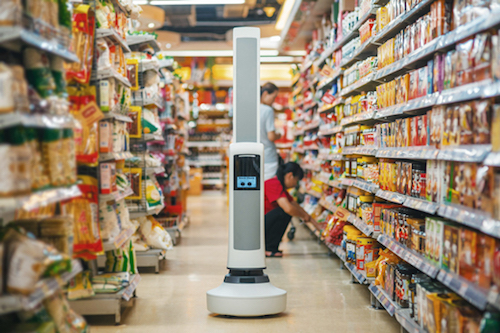
The robot won’t actually be restocking the shelves because that task requires the dexterity of the human hand — for now at least. But developers are engaged in a race to build a machine that can move objects around as well as a person. Ground zero for that technology is the Amazon Robotics Challenge, an annual contest for a robot that can physically pack an order into a box for shipment (which is taking place this week, as it happens). A machine that can pick and pack like a human hand will have a lot of job-killing applications beyond the Amazon warehouse.
The Tally robot is a creation of Simbe Robotics in San Francisco. The company has a pleasantly reassuring video with a Strauss waltz playing — though there’s no mention of the jobs lost since a human with a clipboard is no longer needed.
The retail business is about to be transformed by automation, including the shopping experience for consumers, and the result will be severe job loss. Hardest-hit will be cashiers, because self-checkout is a simple technology. In May, the financial services firm Cornerstone Capital Group forecast that between 6 million to 7.5 million retail jobs are at risk of being automated over the next 10 years. What are those people supposed to do for a living when the same technological forces are knocking many other unskilled jobs? President Trump’s efforts at increasing jobs are having an effect, but the long term looks unpromising.
Eric Brynjolfsson, tech author from MIT, recently remarked about the revolution in retail (Amazon’s Move Signals End of Line for Many Cashiers, NYTimes, June 17, 2017):
“Amazon didn’t go put a robot into the bookstores and help you check out books faster. It completely reinvented bookstores. The idea of a cashier won’t be so much automated as just made irrelevant — you’ll just tell your Echo what you need, or perhaps it will anticipate what you need, and stuff will get delivered to you.”
The shopping experience that tech wizards are designing sounds pretty sterile, but it would be an improvement over sales helpers who don’t speak English well (as I reflected yesterday while shopping for manila folders at Staples).
The future will automated. To prepare for it, the least Washington could do is severely limit immigration, say by about 99 percent, because AUTOMATION MAKES IMMIGRATION OBSOLETE.
]]>The robot invasion has begun in the grocery aisle, New York Post, July 27, 2017
A family-owned grocery chain in the Midwest is set to test an aisle-roving robot, joining technology-savvy retail behemoths like Amazon and Walmart.
The robot, named Tally, will begin scanning store aisles at three St. Louis-area Schnucks grocery stores in a six-week pilot program starting on Monday. The robot will check aisles three times a day to look for out-of-stock items and make sure items and price tags properly correspond, company officials say.
“We’re excited to see what this partnership brings,” Dave Steck, the chain’s vice president of IT and infrastructure, said in a statement on its collaboration with San Francisco-based Simbe Robotics. “This is just one of many ways that Schnucks is staying at the forefront of technology to enhance our customers’ shopping experiences.”
Schnucks — which operates more than 100 stores in Missouri, Illinois, Indiana, Wisconsin and Iowa — will initially use the adjustable 38-inch, 30-pound robot to monitor items on store shelves but is hopeful that the robot “may open up a world of other possibilities” with the data it collects, Steck said.
The robots are the first test of the technology in Missouri and could expand to other Schnucks locations, the St. Louis Post-Dispatch reports.
Simbe CEO Brad Bogolea told the newspaper that the robot’s ability to find items that need to be restocked and pricing errors allows employees to focus on other tasks. The robot has already been scanning aisles in other stores across the country, including some Target stores in San Francisco last year.
“The goal of Tally is to create more of a feedback mechanism,” Bogolea told the newspaper. “Although most retailers have good supply chain intelligence, and point-of-sale data on what they’ve sold, what’s challenging for retailers is understanding the true state of merchandise on shelves. Everyone sees value in higher quality, more frequent information across the entire value chain.”
Steck, meanwhile, said the robot isn’t being tested to one day replace human employees.
“This is not to displace jobs,” he told the Post-Dispatch. “It still takes someone to order [merchandise], receive it from the warehouse and ultimately to stock it. There are no arms or legs on this robot.”
Amazon, which announced last month it will acquire Whole Foods, is planning to slash cashier jobs as part of an overall strategy to automate jobs and cut prices, Bloomberg reported. An Amazon spokesman denied that job cuts were planned at Whole Foods.
A source told The Post in February that Amazon planned to “utilize technology to minimize labor” at new, automated supermarkets that could operate with as few as three employees.
Walmart, meanwhile, has also filed a patent to use drones in its stores, which would allow the flying robots to “carry the item of inventory to a delivery area” located within the store, according to a patent application.
The LoweBot hardware store machine welcomes shoppers and offers them directions about where to find their desired items.

Also, a back-office cash-counter job lost to a smart machine occurs out of the public eye, like so many others. It’s great that President Trump’s economic and trade policies are emphasizing Made in America, but the long term trend is toward more automation and fewer human workers. In addition, automation is a worse cause of factory job loss than bad trade deals.
The automated future has been sketched out by various experts. Oxford researchers forecast in 2013 that nearly half of American jobs were vulnerable to machine or software replacement within 20 years. Rice University computer scientist Moshe Vardi believes that in 30 years humans will become largely obsolete, and world joblessness will reach 50 percent. The Gartner tech advising company believes that one-third of jobs will be done by machines by 2025. Forrester Research Inc. has a more optimistic view, that there will be a net job loss of 7 percent by 2025 from automation.
The retail industry is particularly susceptible to automation, with cashiers being first on the chopping block because self-checkout is very simple technology. Six million retail jobs could be lost in the next decade.
Plus, retail is getting clobbered by Amazon, which could not function without robots and computerization.
It’s baffling how Washington can be so clueless about the revolution beginning to occur in America’s workplaces. Perhaps the Masters of the Universe are in mass denial because they cannot think of a fix, or maybe the swamp gas is just too thick for them to see what’s happening.
Not a whole lot can be done, since the market forces toward cheaper means of production are powerful. But it certainly makes sense to end immigration entirely since the need to import inexpensive foreign workers is over. In fact,
Automation Makes Immigration Obsolete.
So don’t mend it: end it.
]]>Robots Are Replacing Workers Where You Shop, Wall Street Journal, July 19, 2017
Wal-Mart and other large retailers, under pressure from Amazon, turn to technology to do workers’ rote tasks
Last August, a 55-year-old Wal-Mart employee found out her job was being taken over by a robot. Her task was to count cash and track the accuracy of the store’s books from a desk in a windowless backroom. She earned $13 an hour.
Instead, Wal-Mart Stores Inc. started using a hulking gray machine that counts eight bills per second and 3,000 coins a minute. The Cash360 machine digitally deposits money at the bank, earning interest for Wal-Mart sooner than if sent by armored car. And the machine uses software to predict how much cash is needed on a given day to reduce excess.
“They think it will be a more efficient way to process the money,” said the employee, who has worked with Wal-Mart for a decade.
Now almost all of Wal-Mart’s 4,700 U.S. stores have a Cash360 machine, making thousands of positions obsolete. Most of the employees in those positions moved into store jobs to improve service, said a Wal-Mart spokesman. More than 500 have left the company. The store accountant displaced last August is now a greeter at the front door, where she still earns $13 an hour.
“The role of service and customer-facing associates will always be there,” said Judith McKenna, Wal-Mart’s U.S. chief operating officer. But, she added, “there are interesting developments in technology that mean those roles shift and change over time.”
Shopping is moving online, hourly wages are rising and retail profits are shrinking—a formula that pressures retailers, ranging from Wal-Mart to Tiffany & Co., to find technology that can do the rote labor of retail workers or replace them altogether.
As Amazon.com Inc. makes direct inroads into traditional retail with its plans to buy grocer Whole Foods Market Inc., Wal-Mart and other large retailers are under renewed pressure to invest heavily to keep up.
Economists say many retail jobs are ripe for automation. A 2015 report by Citi Research, co-authored with researchers from the Oxford Martin School, found that two-thirds of U.S. retail jobs are at “high risk” of disappearing by 2030.
